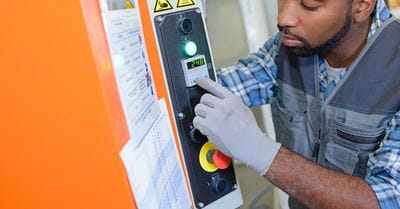Vertical Reciprocating Conveyors | Sacramento

Raymond West supplies warehouse automation equipment such as VRC's.
We are among the largest suppliers of warehouse automation equipment in the state.
Call us today at (800) 675-2500.
What Is a Vertical Reciprocating Conveyor (VRC)?
A VRC is an efficient, cost effective, convenient way to move materials from one level to another. VRCs have applications in countless industries, including manufacturing plants, storage facilities, distribution centers, and other multi-story facilities. These versatile pieces of equipment can be readily integrated with a building’s basement, mezzanine, balcony or any upper floor levels.
Vertical reciprocating conveyors are made up of a shaft, a cage, and a hydraulic or mechanical system. Vertical material lifts can be added just about anywhere on the interior or exterior of a building. Gates and cages surrounding a VRC shaft keep workers safe and prevent accidents.
What Are Some Advantages of VRCs?
Safety: Many operations rely on forklifts for vertical movement of products. Although highly capable machines, forklifts are mainly designed for the horizontal movement of goods. In the name of efficiency, workers may sometimes stretch their forklifts above their vertical limit or transport loads beyond their truck’s capacity rating. When these transgressions happen, the probability of a serious accident increase substantially.
For some vertical product movement, VRCs provide a safe and effective replacement for lift trucks. Specifically engineered and manufactured for each facility’s application requirements, VRCs greatly minimize the chances of human error.
Additionally, VRCs are designed to move more substantial loads on a more frequent basis. These more rapid cycle rates result in less labor expenses. For companies that have high volume vertical transport requirements, VRCs can improve safety and decrease costs.
Customization: One major advantage of vertical reciprocating conveyors is the degree to which they can be customized. Because passenger elevators are designed to safely move people, regulations have been put into place that restrict the weight capacity, speed and size of these machines. While such safety measures are necessary and advisable for safely moving humans, they are not necessary for high volume movement of goods in factories, storage facilities and distribution operations. VRCs can be freely customized because they are not saddled with the same regulations as passenger elevators.
Regulation: Vertical reciprocating conveyors are designed to move goods only, while standard elevators are designed to move both passengers and freight. Due to this important distinction, VRCs are free from the rigorous elevator standards in many states.
In place of local jurisdiction, VRCs are regulated by their own national code that is administered by the American Society of Mechanical Engineers (ASME), one of the preeminent standards defining organizations in the country. More specifically, vertical reciprocating conveyors must comply with ASME’s Safety Standard for Conveyor and Related Equipment (ASME B20.1-2018). This standard defines the requirements for the fabrication, installation, operating procedure and servicing of conveyor systems.
Raymond West Is A Full Service Supplier of Vertical Reciprocating Conveyors
If you’re starting the procurement process for a VRC, have questions or require engineering support, Raymond West can give you a hand. Our conveyor system experts can help plan, procure, install and service a system that’s perfect for your business. Call us today!
Raymond West's Sacramento facility serves the greater Sacramento area and other parts of Northern California, including Sacramento, Elk Grove, Auburn, Placerville, Vacaville, Fairfield, Sausalito, Napa, Santa Rosa, Redding, Eureka and all surrounding areas.
Raymond West | Sacramento Material Handling Equipment Supplier
900 National Dr
Sacramento, CA 95834
(800) 675-2500

